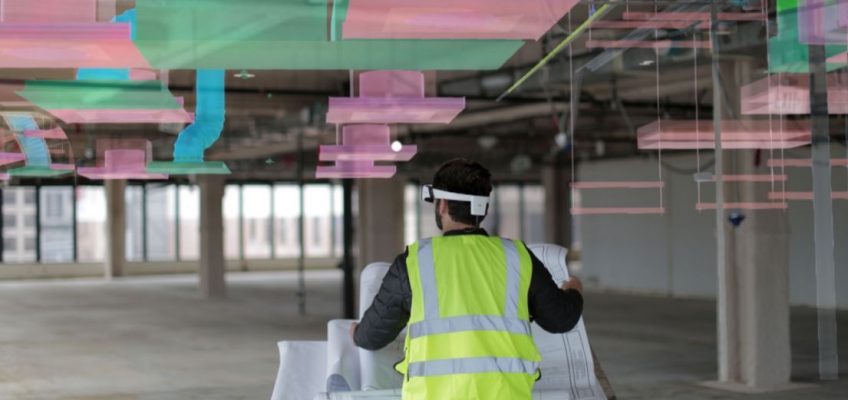More sectors are realizing the potential of immersive technology to dramatically maximize efficiency and profits.
When I demoed the Daqri Worksense Mixed Reality application at the Pioneers conference in Vienna a couple of months ago, what struck me the most – apart from the fact that I was told the glasses made me look like a Minion – was that the visuals were much sharper, and that the additional definition made it feel like this could really be a tool that you could feel comfortable using on a routine basis for longer periods of time – unlike most headset-based immersive experiences at the moment.
Daqri was tested by more than 100 different companies last year in sectors from aerospace sector to construction Share on XThe most obviously useful functionality of these devices is the ability to do video calls on a “you see what I see” basis. You’re wearing the smart glasses, looking at the real-world scenario in front of you, yet at the same time you have this (hopefully) friendly and expert voice in your head telling you how to proceed. When I tried Microsoft Remote Assist with the HoloLens back in May at Microsoft Build I was able to “repair” a complex electrical panel in a matter of minutes. Of course it was a staged demo scenario, but the principle stands. With this type of guidance, you can instantly turn a layperson into at least a semi-competent pair of hands – Forget games and gimmicks. For me, this is where Mixed Reality gets really exciting.
You’re wearing the smart glasses, looking at the real-world scenario in front of you, yet at the same time you have this expert voice in your head telling you how to proceed Share on XDaqri was tested by more than 100 different companies last year in sectors from aerospace sector to construction, and this latest smart assistance product is an Augmented Reality industrial application for wearables such as smart glasses and helmets which supports operators with step-by-step instructions using text, icons, images, 3D models and animations to complete specific tasks. This allows workers to access, capture and send digital information about the activity in real time.
Yet even though Daqri offers a very similar product to the HoloLens, it could very well be that this nascent market will offer plentiful opportunities for both (although it wouldn’t be surprising if we started seeing some significant acquisitions in that space, like the sale of AltspaceVR to Microsoft last year. The competition in that space is growing fast to keep up with this demand, and not just in Europe and the U.S. either.
As immersive technology becomes more ubiquitous, it will offer significant efficiency savings to those that adopt it Share on XDriven by the ambition of cities such as Dubai to push for innovation, the market for VR and AR in the Middle East and Africa is booming, and is expected to reach a massive $6 billion by 2020, according to international analysts International Data Corporation (IDC). Much of this growth is expected to be driven by B2B segments including distribution and manufacturing.
Microsoft in particular has secured an enviable position in the Mixed Reality enterprise space, mainly due to a consistent strategy that recognized this wasn’t a consumer-ready product yet, but instead focused on building partnerships and solid case studies for building industry 4.0 efficiencies.
Driven by the ambition of cities such as Dubai to push for innovation, the market for VR and AR in the Middle East and Africa is booming Share on XThis focus on industry applications has seen the somewhat incongruous integration of Mixed Reality Smart Glasses with gear such as hard hats, or in Daqri’s case, a “smart helmet” which includes a series of sensors capable of recording and interacting with outside world in 360 degrees and a “thermal” vision, which equips workers with a sort of “X-ray view” where they can see inside tubes and machinery to verify they are functioning correctly.
An example of the sort of client that is employing Daqri technology is the Dubai Electricity and Water Authority (Dewa) which worked with Dubai-based company Takeleap, while the HoloLens has been widely used for years in a variety of sectors such as construction, architecture, mining, education, and infrastructure, to name but a few.
The focus on industry applications has seen the somewhat incongruous integration of Mixed Reality Smart Glasses with gear such as hard hats Share on XWith a new version of the HoloLens due to be released this year, and Magic Leap coming out of its semi-permanent stealth mode it remains to be seen which players will set the industry standards for the new medium, but it seems certain that as immersive technology becomes more ubiquitous and offers significant efficiency savings to those that adopt it, very few companies will be able to retain a competitive edge without incorporating it in their processes to some extent.
This article originally appeared on Forbes
Mixed Reality for Industry 4.0https://t.co/T8I0hnJ0vp
— Forbes Tech (@ForbesTech) July 12, 2018
For companies looking to leverage Immersive technologies such as VR/AR/MR/XR Tech Trends offers a comprehensive range of Virtual Reality Consultancy Services.
Alice Bonasio is a VR and Digital Transformation Consultant and Tech Trends’ Editor in Chief. She also regularly writes for Fast Company, Ars Technica, Quartz, Wired and others. Connect with her on LinkedIn and follow @alicebonasio on Twitter.









